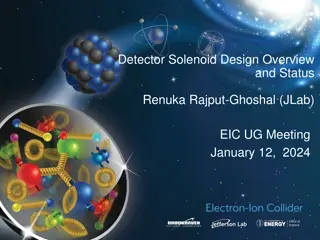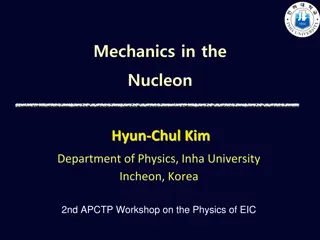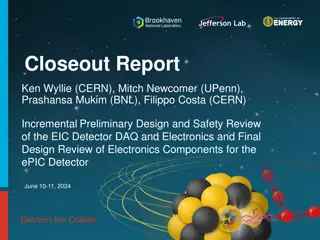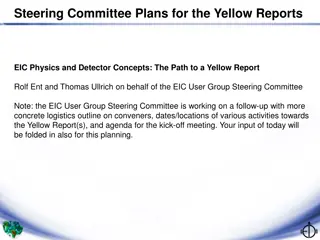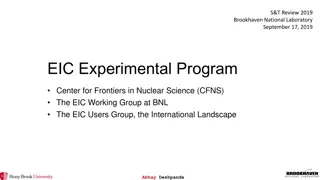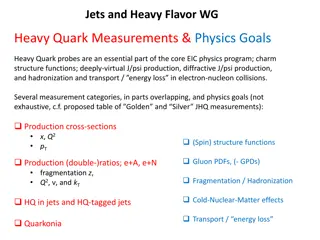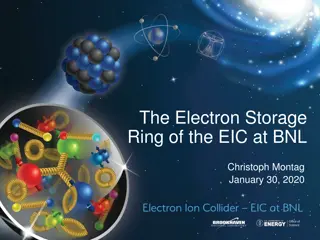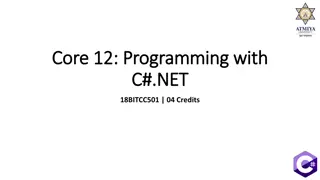
Electron-Ion Collider Detector Proposals and Resource Requests
The EIC has published the Yellow Report and CDR, with collaborations forming for detector proposals. A Computing Working Group has been established to manage simulation resources. Resource requests have been made by ECCE and ATHENA for CPU and storage estimates to meet the short deadline for detector proposals. Background justifications highlight the need for efficient workflows and resources.
Download Presentation

Please find below an Image/Link to download the presentation.
The content on the website is provided AS IS for your information and personal use only. It may not be sold, licensed, or shared on other websites without obtaining consent from the author. If you encounter any issues during the download, it is possible that the publisher has removed the file from their server.
You are allowed to download the files provided on this website for personal or commercial use, subject to the condition that they are used lawfully. All files are the property of their respective owners.
The content on the website is provided AS IS for your information and personal use only. It may not be sold, licensed, or shared on other websites without obtaining consent from the author.
E N D
Presentation Transcript
EIC_NET & CNAF June 10
Informazioni E stato pubblicato lo Yellow Report dell EIC: Science Requirements and Detector Concepts for the Electron-Ion Collider: EIC Yellow Report E stato pubblicato il CDR dell EIC: Conceptual Design Report (CDR) 2021 In marzo stata pubblicata la call for detector proposals con scadenza al primo dicembre 2021 Call for Collaboration Proposals Si sono formate tre proto collaborazioni (INFN in ATHENA): ECCE (EIC COLLIDER EXPERIMENT) ATHENA (A Totally Hermetic Electron-Nucleus Apparatus) CORE (The COmpact detectoR for the Eic)
Informazioni 2 E stato molto recentemente formato il Computing Working Group dell EIC, con il task iniziale di controllo/gestione delle risorse messe a disposizione per le simulazioni delle protocollaborazione Composizione: Jerome Lauret, Graham Heyes and me + representatives from the proto-collaborations (up to two) For Athena is Wouter First action meeting on Monday: Regular contacts with ECCE already started For Athena will start soon For CORE no news First estimates from collaborations received. Will need extra resources from the labs
Resource request from ECCE and ATHENA CPU and storage estimates
Background justification Short time to produce the samples necessary for the detector proposals. Some of the workflows envisioned are conservative (do with what we have as tools, framework, KISS). Estimates should also fold the reality of a changing model (not optimized in many ways) .ATHENA (IP6) CPU: 10 M CPU hours estimated, done by September 3,500 cores at BNL, 5k-7k cores total Storage: 2 PBytes needed Will fit in 2 GB memory / job Overall needs CORE unknow - assuming CPU and 30% less storage (revised storage estimates on the next slide include 25% contingency) CPU is a non-issue 2x2k CPUs (BNL and JLab) - 4k available Assuming CORE @ 1,000 CPUs, 8k core possible modulo recovering 4k slots from the OSG Memory is standard - wide available of off-the- shelf HTC nodes on the Grid Storage - Revised ECCE estimates [3PE approach] indicates a 1.5 Pbytes / collaboration need Assuming 4 PBytes needed total (1.5x2 + 1 CORE) 1 PBytes available at BNL, 1 PBytes being investigated at JLab, we will be short by 2 PBytes Possible squeeze: some sample may be stored on tape (tape will need to be purchased) MINIMUM additional not accounted for +1 PBytes CORE So far, no feedback provided ECCE CPU: 2k-3.5k cores estimates, 4 months usage at 75% capacity (3 months + 30% contingency) Storage: 2 PBytes of simulation output, 100 TB of analysis - estimated based on 1 Billion events (sPHENIX simulations @30 TB per 100 Million events) Will fit in < 2 GB memory / job
Estimates verifications by ECCE (storage and memory) Topics SIDIS acceptance and unfolding matrix, full Geant 4 simulations, 70 x-Q^2 bins [YR Fig 7.50], 16 Phi bins, 10k events per bins => ~ 100 M events (low end) HF physics and background signal - 100 M events, G4 simulation to qualify fast background simulation Exclusive process - 1 Milion events Overall event counts = 200 M events Cardinality: x3 simulation campaigns x 1-3 configuration options => assuming 1 Billion events Detailed plan First iteration/May : 1 detector option Second iteration/June-July : 3 detector options Third iteration/July-Sept: 2 detector options Verifications The first event sample produced (1 M events) show a size of 300 GB - simplest configuration possible, 100 M == 30 TB 100 million events of p+p events in sPHENIX requires 130 TB of storage (pp multiplicity higher than ep but no forward detectors ) Mean memory was measured to be 1.GB with an stdev of 200 MB.- a standard 1.5 GB of memory will be good Assumption: 1 Billion events required 2 Pbytes is remarkably consistent between ECCE and ATHENA initial evaluation (assuming most likely value) ECCE provides two more points - an optimistic lower bound and a pessimistic value Assuming a triangular distribution and still a 25% contingency, 1.5 Pbytes seems needed per proto-collaboration Note: perhaps 30% could be archived on tape (this will be considered in our minimal estimates for a purchase but tape will then need o be purchased) - in progress

